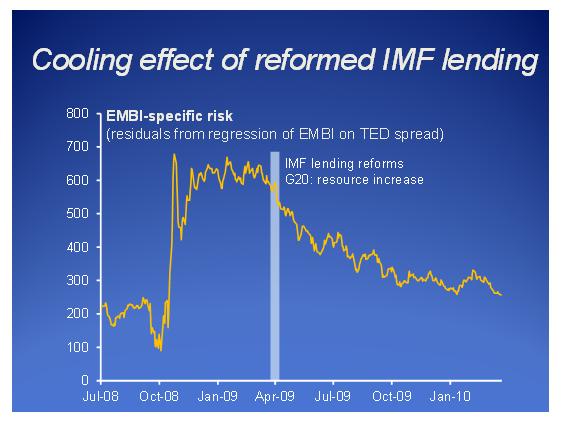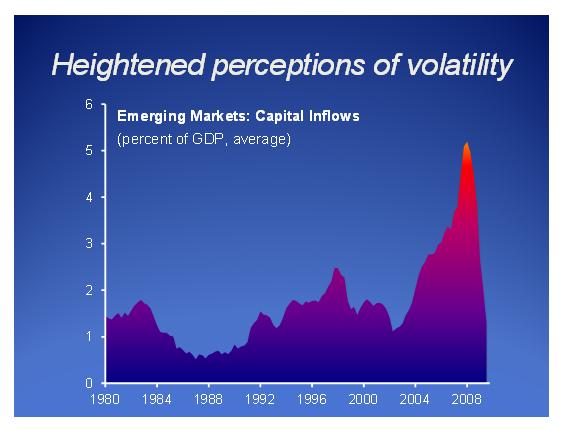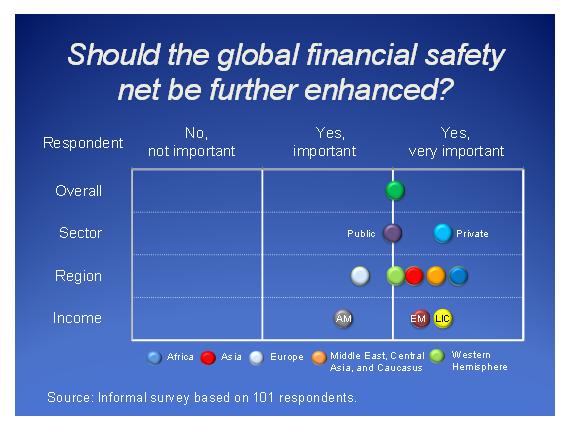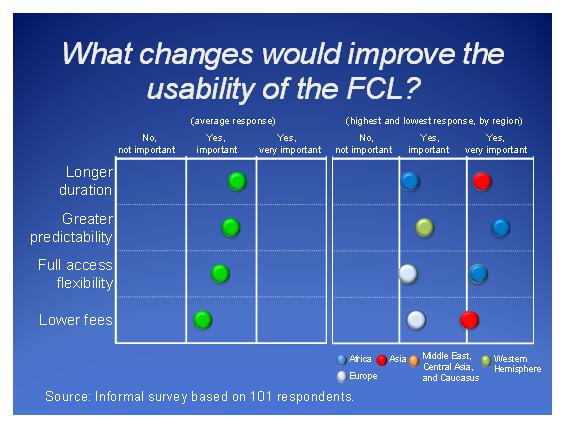Let’s rewind the tape to October 2008. Barely a couple of weeks have passed since Lehman filed for bankruptcy, and emerging markets are selling off like crazy. The vaunted “decoupling” theories—hailed as visionary only a few months before—lie in tatters as investors flee in droves. With its mandate to foster global economic stability, the IMF comes under the spotlight: many observers question whether the institution has what it takes to stop contagion and help emerging markets cope with global deleveraging.
With strong support from its membership, the IMF did not hesitate to come to the rescue. It provided large and upfront financial assistance to help countries weather the crisis. It overhauled its lending toolkit, notably by establishing the Flexible Credit Line (an instrument allowing countries with very strong policies to tap IMF resources unconditionally). And, importantly, its membership, building on the political momentum of the G-20, committed to tripling its resource base. These actions helped put out the fire, setting emerging market spreads on a downward trajectory.
A new paper on rethinking the IMF’s financing role (a key aspect of our broader work on modernizing the IMF mandate) reviews the effectiveness of reformed lending and draws on the lessons of the crisis to improve IMF instruments further.
A multilayered global financial safety net
The large shocks observed during the recent crisis have heightened countries’ perception of volatility and contagion risks.
Unsurprisingly, policymakers, market participants, and academic observers all agreed on the need to further strengthen the global financial safety net, of which IMF lending is at the core.
But what does this mean? It requires
- Increasing the resilience to shocks of countries receiving capital flows, principally through improved policies. Adequacy of reserves is also important, but the associated benefits tend to have diminishing returns (an issue I have recently blogged on).
- Avoiding excessive risk-taking through better supervision in countries generating capital flows.
- Leveraging financing vehicles such as central bank swap lines, regional financing arrangements (e.g., the Chiang Mai initiative), multilateral development bank lending, and IMF financial assistance.
But what is the role of these seemingly overlapping bilateral and multilateral vehicles? They complement each other in helping countries manage volatility and contagion risks. Central banks have a natural advantage in alleviating short-term liquidity pressures—the swap lines in the recent crisis played an instrumental role in recycling dollar liquidity. By pooling regional reserves, regional financing arrangements can help address idiosyncratic shocks. Lending by multilateral development banks, such as the World Bank, mainly aims at supporting long-term growth. The role of the IMF is mostly to provide countercyclical lending, and is different from that of other institutions given its global reach, preferred creditor status, large resources, and its ability to catalyze private lending through agreed policy frameworks.
Enhancing the IMF’s crisis prevention and management capability
But we can build even further on the progress made during the crisis to leverage the IMF’s unique characteristics and enhance the crisis prevention toolkit.
- The Flexible Credit Line, which was used to good effect by Mexico, Colombia, and Poland during the recent crisis, could be made even more effective by lengthening its duration (currently six months) and making country qualification more predictable.
- To help ensure that the Fund offers effective crisis prevention instruments also to those well performing countries but that do not qualify for the Flexible Credit Line, one option would be to introduce a new crisis prevention instrument (the Precautionary Credit Line). This would provide upfront access to financing as in the Flexible Credit Line, but, differently from that instrument, would allow for some (light and focused) policy conditionality.
Management of systemic crises is another area where improvements could be made in the IMF lending toolkit. In particular, the IMF needs to be able to proactively erect a firewall to protect innocent bystanders from the spread of virulent systemic shocks. While some central banks did play such a role during the recent crisis, there is a strong case for building on this for the future. First, given the necessarily ad hoc nature of national central bank responses there is a need for a transparent and predictable standing facility. Second, given the global reach of systemic crises, there is a need for a global, rather than a national or regional solution. Third, the nature of the next systemic crisis may be different, raising doubts on whether central banks may be called into action, One option would be to establish a Multicountry Swap Line (MSL) as a mechanism enabling the IMF to make a unilateral and simultaneous offer of short-term liquidity lines to a limited set of systemically important countries with strong policy track records.
What about moral hazard?
Further enhancements to the IMF lending toolkit along the lines suggested above would increase the IMF’s ability to prevent crises and mitigate the cost of systemic shocks. To add credibility, the IMF resource base needs to be adequate to deal with most shocks. Some observers, however, worry that a large IMF with beefed-up financing instruments would add to moral hazard, encouraging reckless lending or unsafe policies. This is less of an issue when IMF lending is targeted to deal with “exogenous” shocks, i.e., shocks that cannot be influenced by the behavior of the individual country or its creditors. A relevant example here is a systemic liquidity shock, affecting “innocent bystanders” as in the MSL. But moral hazard is a more legitimate concern when dealing with idiosyncratic shocks. This is why, as a general principle, financial assistance to members with weaker track records needs to be subject to the observance of policy conditions. Conversely, instruments providing upfront financing should be dedicated exclusively to countries with stronger policy track records.
In the coming months, we will do more work on these issues with the aim of distilling specific proposals on revamping the IMF lending toolkit by the fall. In the meantime, I welcome your feedback.








